Fatigue Characteristics of Steel–Concrete Composite Beams
Abstract
1. Introduction
2. Experimental Program
3. Results and Discussions
3.1. Crack Distribution and Formation
3.2. Cyclic Deformations
3.3. Cyclic Strains
3.4. Cyclic Post-Tensioning Force
4. Residual Static Behavior
5. Conclusions
- The longitudinal fatigue shear fractures in the concrete slab were mostly controlled by the degree of the shear connection between the concrete slabs and steel beams. Moreover, the range of shear stress in the headed connectors affected the formation and distribution of fatigue cracks in the concrete slab.
- By increasing the loading cycles owing to the damaged region that developed in the concrete slab by the headed connectors and which produced a loss of stiffness in the shear connection, an increase in the residual deformations was achieved.
- The specimen with partial shear connections showed a quick rise in the residual mid-span deflection, and got the greatest enduring deformation in comparison to specimens with the full shear connection.
- The external post-tensioning greatly reduced the stresses in the shear connections, concrete slab, and steel beam. However, across the shear span areas, fractures in the longitudinal and transverse directions were developed and spread in the concrete slab of the post-tensioned specimen between the rows of the headed connectors.
- The findings provided in this research show that a larger number of smaller studs with the appropriate shear resistance exhibited more advantageous behavior than a smaller number of larger diameters.
- While cyclic loads led to a reduction in the shear connection, the intact shear connection successfully averted any deterioration in stiffness and strength for the remaining fatigue specimens.
Author Contributions
Funding
Data Availability Statement
Conflicts of Interest
References
- Bonopera, M.; Chang, K.C.; Tullini, N. Vibration of prestressed beams: Experimental and finite-element analysis of post–tensioned thin-walled box-girders. J. Constr. Steel Res. 2023, 205, 107854. [Google Scholar] [CrossRef]
- Wang, B.; Wang, K.; Liu, X.; Xu, Y. Residual Flexural Capacity of Composite Beams with Corroded Studs after Fatigue. J. Bridge Eng. 2023, 28, 04023026. [Google Scholar] [CrossRef]
- Wang, B.; Huang, Q.; Liu, X.; Li, W. Experimental investigation of steel-concrete composite beams with different degrees of shear connection under monotonic and fatigue loads. Adv. Struct. Eng. 2018, 21, 227–240. [Google Scholar] [CrossRef]
- Wang, B.; Liu, X.; Zhuge, P. Residual bearing capacity of steel-concrete composite beams under fatigue loading. Struct. Eng. Mech. 2021, 77, 559–569. [Google Scholar] [CrossRef]
- Xu, J.; Sun, H.; Chen, W.; Guo, X. Experiment-Based Fatigue Behaviors and Damage Detection Study of Headed Shear Studs in Steel–Concrete Composite Beams. Appl. Sci. 2021, 11, 8297. [Google Scholar] [CrossRef]
- Tran, M.-T.; Do, V.N.V.; Nguyen, T.-A. Behaviour of steel-concrete composite beams using bolts as shear connectors. IOP Conf. Ser. Earth Environ. Sci. 2018, 143, 012027. [Google Scholar] [CrossRef]
- Lu, K.; Du, L.; Xu, Q.; Yao, Y.; Wang, J. Fatigue performance of stud shear connectors in steel-concrete composite beam with initial damage. Eng. Struct. 2023, 276, 115381. [Google Scholar] [CrossRef]
- Kuang, Y.; Wang, Y.; Xiang, P.; Tao, L.; Wang, K.; Fan, F.; Yang, J. Experimental and Theoretical Study on the Fatigue Crack Propagation in Stud Shear Connectors. Materials 2023, 16, 701. [Google Scholar] [CrossRef] [PubMed]
- El-Sisi, A.A.; Hassanin, A.I.; Shabaan, H.F.; Elsheikh, A.I. Effect of external post-tensioning on steel–concrete composite beams with partial connection. Eng. Struct. 2021, 247, 113130. [Google Scholar] [CrossRef]
- El-Zohairy, A.; Salim, H.; Saucier, A. Steel-Concrete Composite Beams Strengthened with Externally Post-Tensioned Tendons under Fatigue. J. Bridge Eng. 2019, 24, 04019027. [Google Scholar] [CrossRef]
- Hassanin, A.I.; Fawzy, H.M.; Elsheikh, A.I. Elsheikh. Fatigue loading characteristic for the composite steel-concrete beams. Frat. Integrità Strutt. 2021, 55, 110–118. [Google Scholar]
- El-Zohairy, A.; Salim, H. Parametric study for post-tensioned composite beams with external tendons. Adv. Struct. Eng. 2017, 20, 1433–1450. [Google Scholar] [CrossRef]
- El-Zohairy, A.; Salim, H.; Saucier, A. Fatigue tests on steel-concrete composite beams subjected to sagging moments. J. Struct. Eng. 2019, 145, 04019029. [Google Scholar] [CrossRef]
- AASHTO. AASHTO LRFD Bridge Design Specifications, 6th ed.; AASHTO: Washington, DC, USA, 2012. [Google Scholar]
- ASTM A370; Standard Test Methods and Definitions for Mechanical Testing of Steel Products. ASTM International: West Conshohocken, PA, USA, 2013.
- Albrecht, P.; Lenwari, A. Fatigue Strength of Repaired Prestressed Composite Beams. J. Bridge Eng. 2008, 13, 409–417. [Google Scholar] [CrossRef]



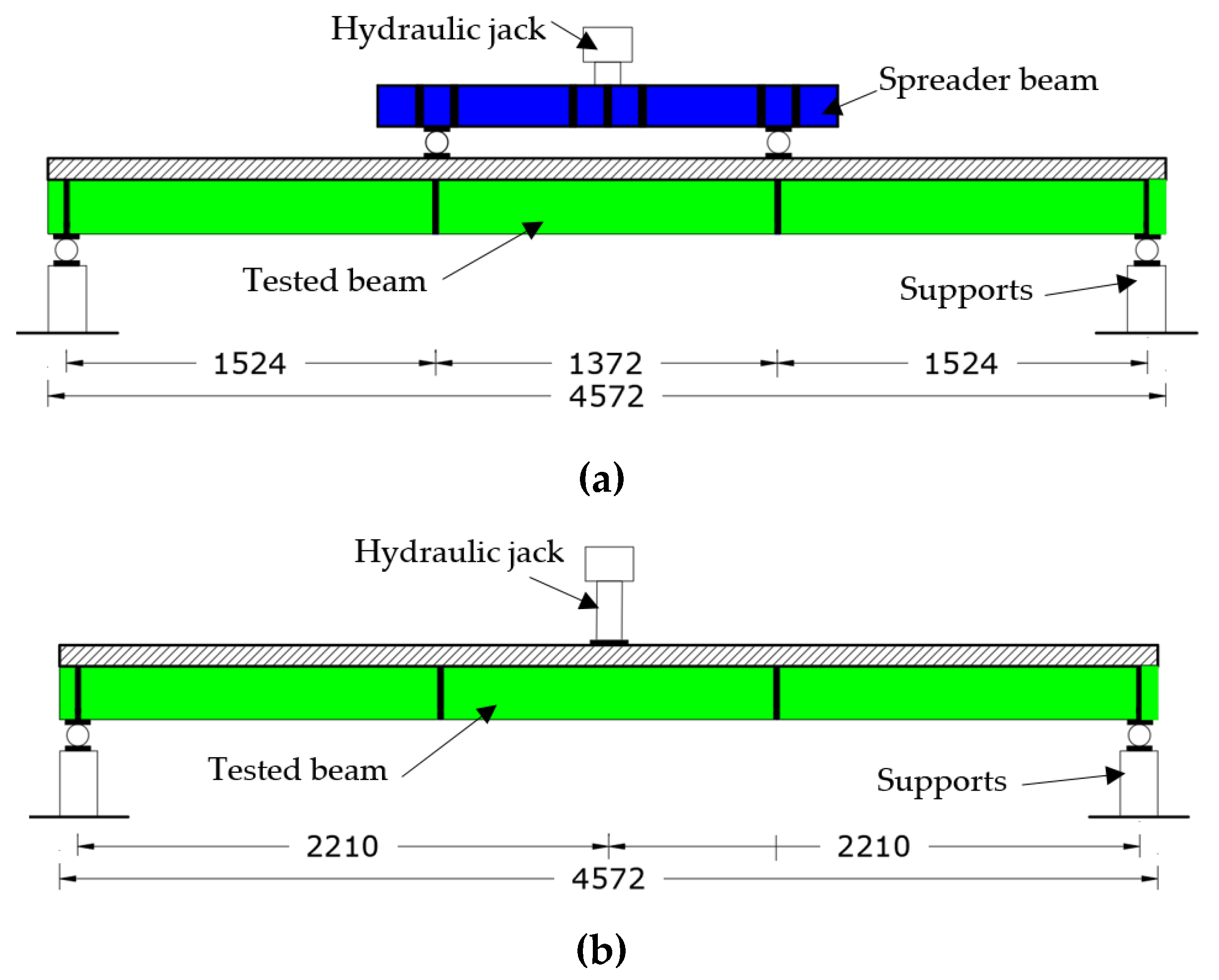
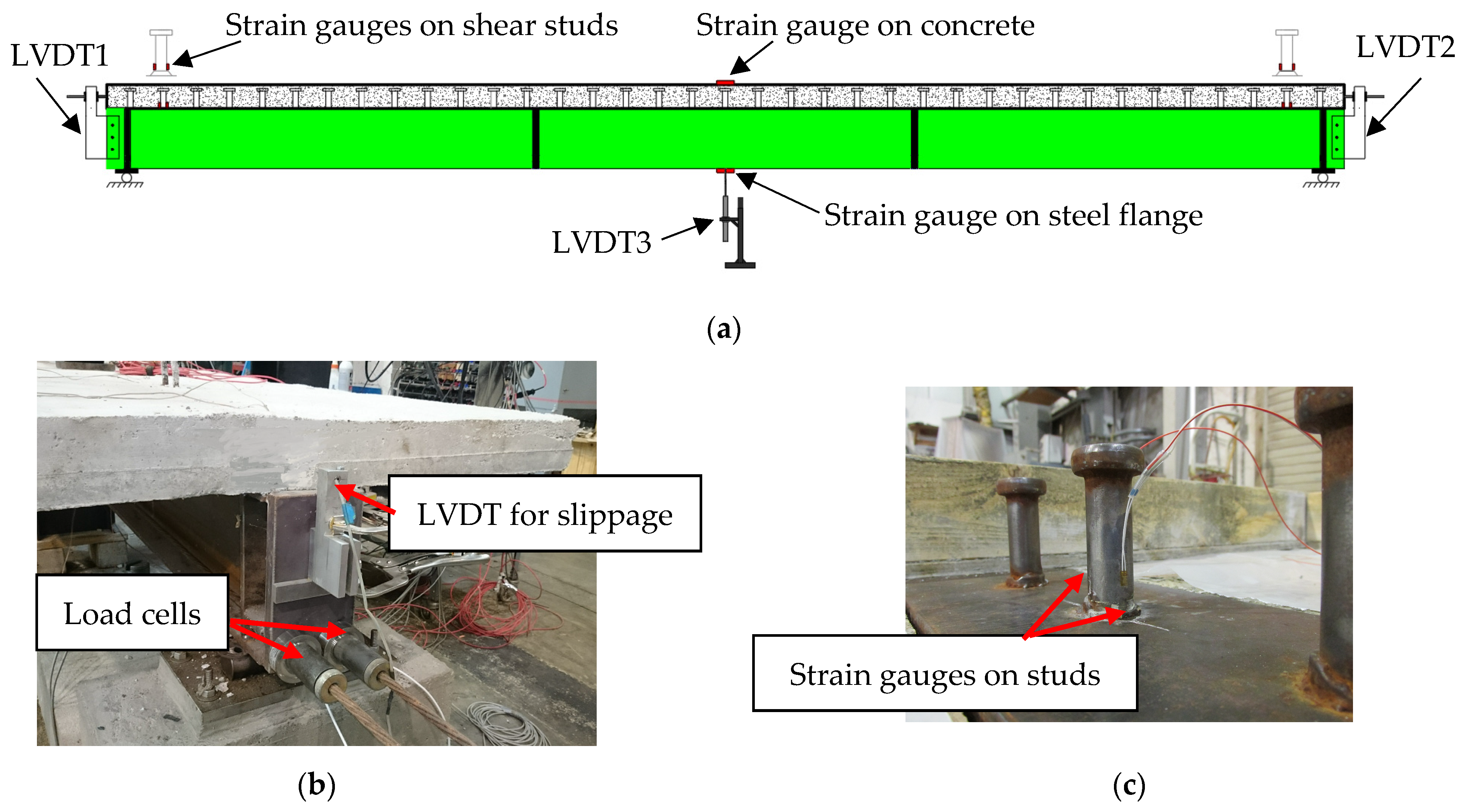
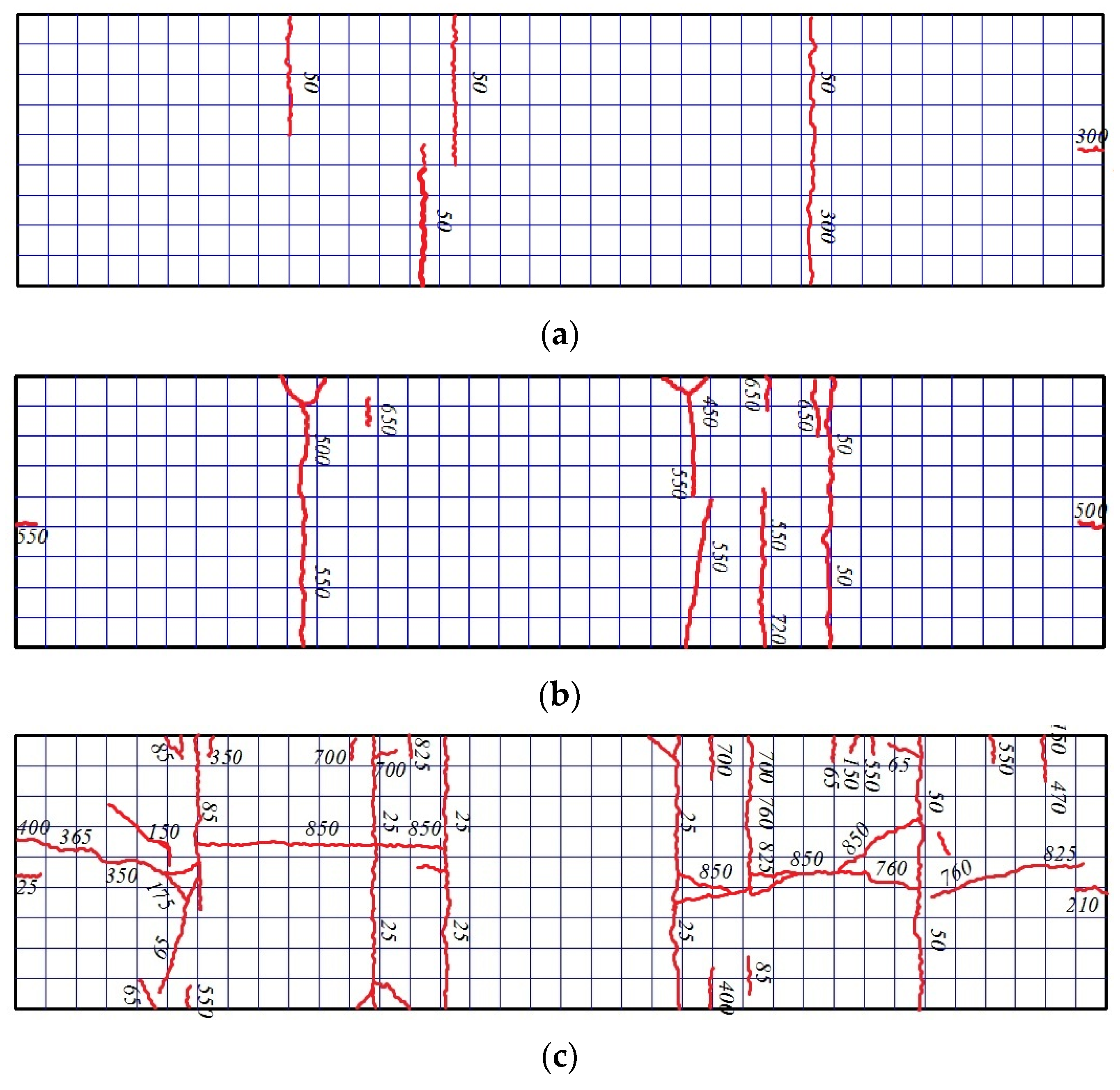



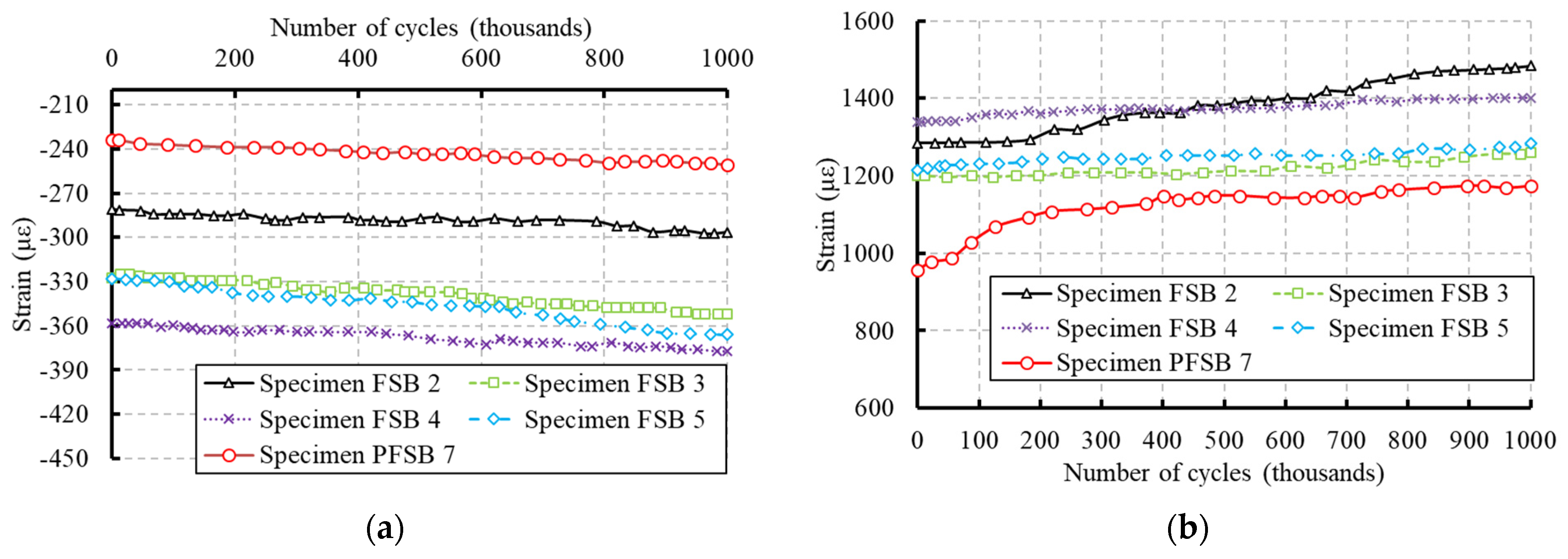


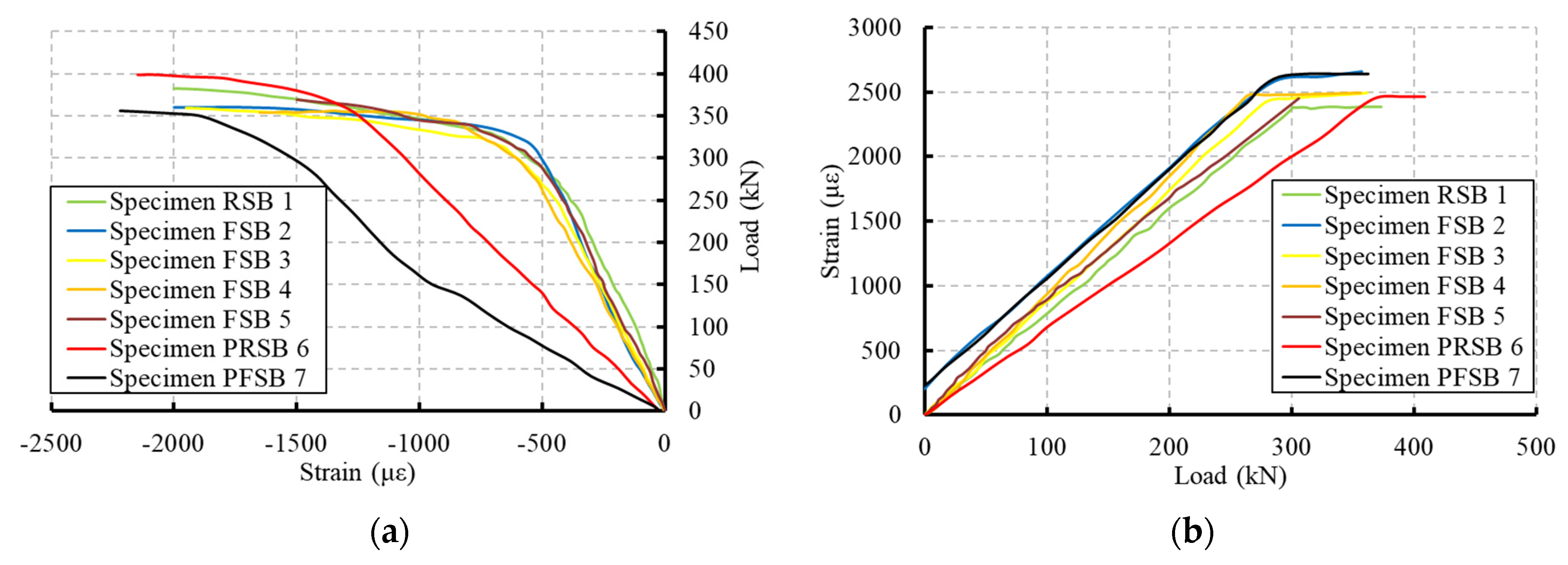
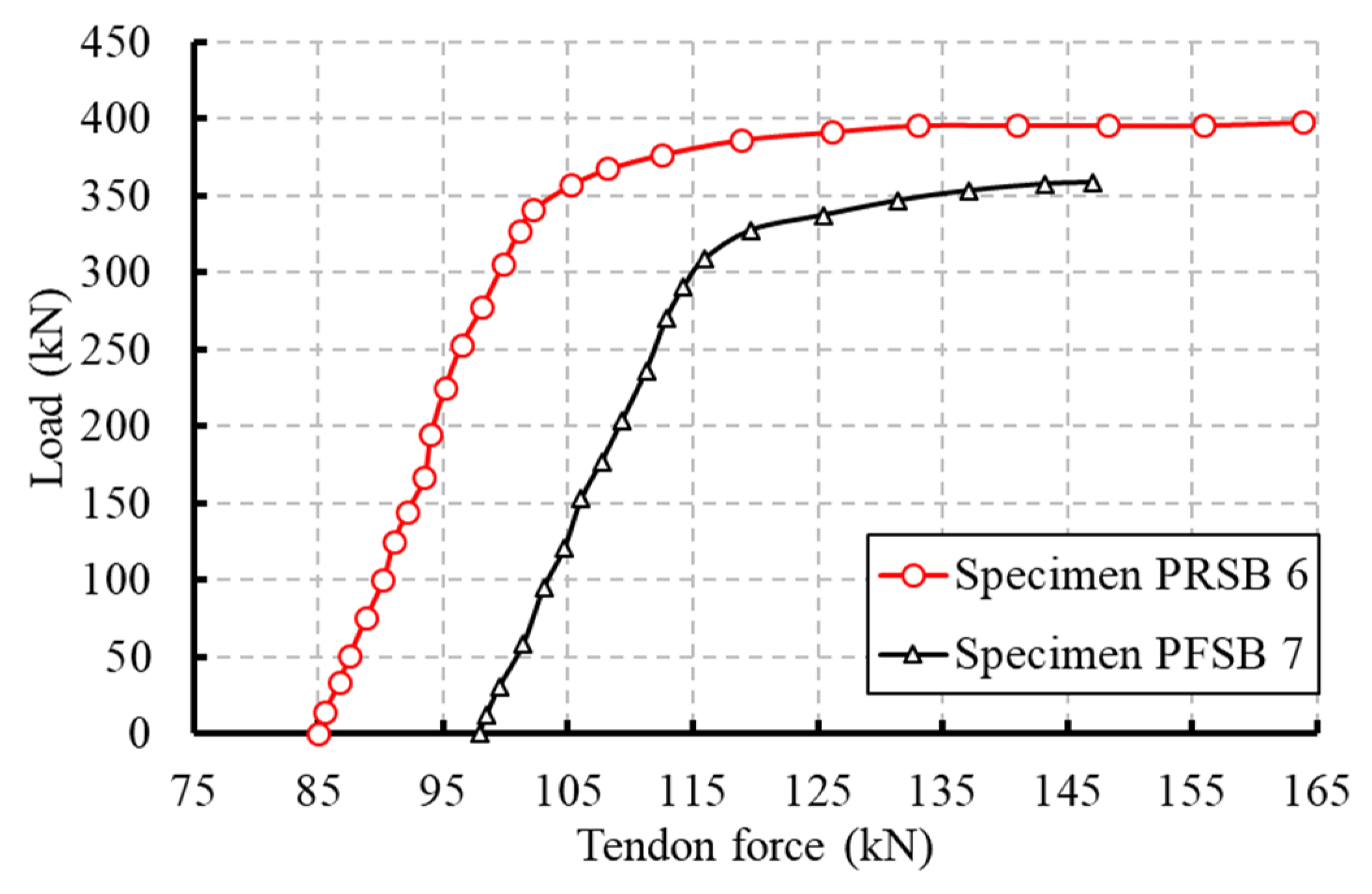
| Specimen | Composite Level | Diameter (mm) | No. of Rows | Spacing of Shear Connectors (mm) | Spacing of Steel Rebars (mm) | ||
|---|---|---|---|---|---|---|---|
| Longitudinal | Transverse | Longitudinal | Transverse | ||||
| RSB 1 | Full (1.0) | 15.9 | Two | 122.2 | 63.5 | 215.9 | 122.2 |
| FSB 2 | Full (1.0) | 15.9 | Two | 122.2 | 63.5 | 215.9 | 122.2 |
| FSB 3 | Full (1.0) | 15.9 | Two | 122.2 | 63.5 | 215.9 | 122.2 |
| FSB 4 | Partial (0.6) | 15.9 | Two | 209.5 | 63.5 | 215.9 | 104.8 |
| FSB 5 | Full (1.0) | 22.2 | One | 112.7 | - | 215.9 | 113.0 |
| PRSB 6 | Full (1.0) | 15.9 | Two | 122.2 | 63.5 | 215.9 | 122.2 |
| PFSB 7 | Full (1.0) | 15.9 | Two | 122.2 | 63.5 | 215.9 | 122.2 |
| Specimen | Level of Shear Connectivity | Fatigue Load (kN) | Shear Stress Range (MPa) | No. of Cycles (103) | ||
|---|---|---|---|---|---|---|
| Upper Limit | Lower Limit | Range | ||||
| RSB 1 | 1.0 | - | - | - | - | - |
| FSB 2 | 1.0 | 160.1 | 13.3 | 146.8 | 77.0 | 1000 |
| FSB 3 | 1.0 | 177.9 | 13.3 | 164.6 | 87.4 | 1000 |
| FSB 4 | 0.6 | 160.1 | 13.3 | 146.8 | 132.2 | 1000 |
| FSB 5 | 1.0 | 177.9 | 13.3 | 164.6 | 81.3 | 1000 |
| PRSB 6 | 1.0 | - | - | - | - | - |
| PFSB 7 | 1.0 | 160.1 | 13.3 | 146.8 | 77.0 | 1000 |
| Steel Rebars | Concrete | Steel Beam | Headed Studs | ||||||
|---|---|---|---|---|---|---|---|---|---|
| fy (MPa) | fu (MPa) | E (GPa) | fc′ (MPa) | fy (MPa) | fu (MPa) | E (GPa) | fy (MPa) | fu (MPa) | E (GPa) |
| 294.2 | 402.5 | 207.8 | 32.4 | 345 | 450 | 204 | 351.6 | 448.2 | 206.5 |
| Specimen | Level of Shear Connectivity | Peak Load | Yielding Load | Slippage | |||
|---|---|---|---|---|---|---|---|
| kN | % Change | kN | % Change | mm | % Change | ||
| RSB 1 | Full | 378.7 | ---- | 295.2 | ---- | 0.06 | ---- |
| FSB 2 | Full | 363.8 | −3.9 | 285.9 | −3.2 | 0.10 | +66.7 |
| FSB 3 | Full | 361.9 | −4.4 | 277.3 | −6.1 | 0.11 | +83.3 |
| FSB 4 | Partial | 355.4 | −6.2 | 240.6 | −18.5 | 0.16 | +166.7 |
| FSB 5 | Full | 370.0 | −2.6 | 299.0 | −1.6 | 0.11 | +83.0 |
| PRSB 6 | Full | 402.3 | ---- | 341.0 | ---- | 0.04 | ---- |
| PFSB 7 | Full | 350.8 | −12.8 | 300.0 | −12.0 | 0.13 | +225.0 |
Disclaimer/Publisher’s Note: The statements, opinions and data contained in all publications are solely those of the individual author(s) and contributor(s) and not of MDPI and/or the editor(s). MDPI and/or the editor(s) disclaim responsibility for any injury to people or property resulting from any ideas, methods, instructions or products referred to in the content. |
© 2024 by the authors. Licensee MDPI, Basel, Switzerland. This article is an open access article distributed under the terms and conditions of the Creative Commons Attribution (CC BY) license (https://creativecommons.org/licenses/by/4.0/).
Share and Cite
El-Zohairy, A.; Salim, H.; Shaaban, H.; Nawar, M.T. Fatigue Characteristics of Steel–Concrete Composite Beams. Infrastructures 2024, 9, 29. https://doi.org/10.3390/infrastructures9020029
El-Zohairy A, Salim H, Shaaban H, Nawar MT. Fatigue Characteristics of Steel–Concrete Composite Beams. Infrastructures. 2024; 9(2):29. https://doi.org/10.3390/infrastructures9020029
Chicago/Turabian StyleEl-Zohairy, Ayman, Hani Salim, Hesham Shaaban, and Mahmoud T. Nawar. 2024. "Fatigue Characteristics of Steel–Concrete Composite Beams" Infrastructures 9, no. 2: 29. https://doi.org/10.3390/infrastructures9020029
APA StyleEl-Zohairy, A., Salim, H., Shaaban, H., & Nawar, M. T. (2024). Fatigue Characteristics of Steel–Concrete Composite Beams. Infrastructures, 9(2), 29. https://doi.org/10.3390/infrastructures9020029







